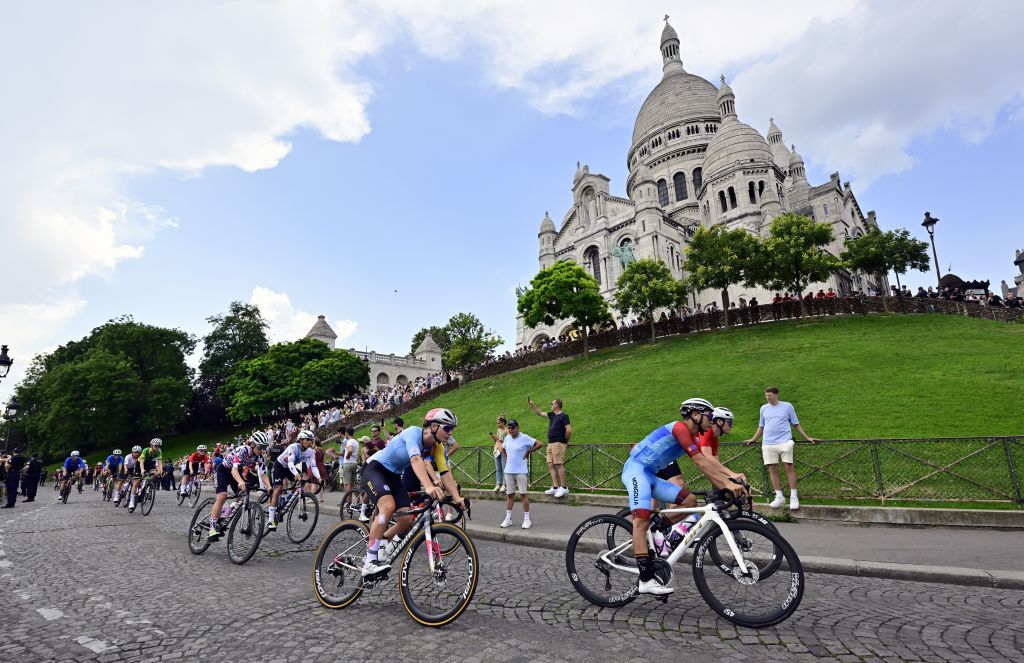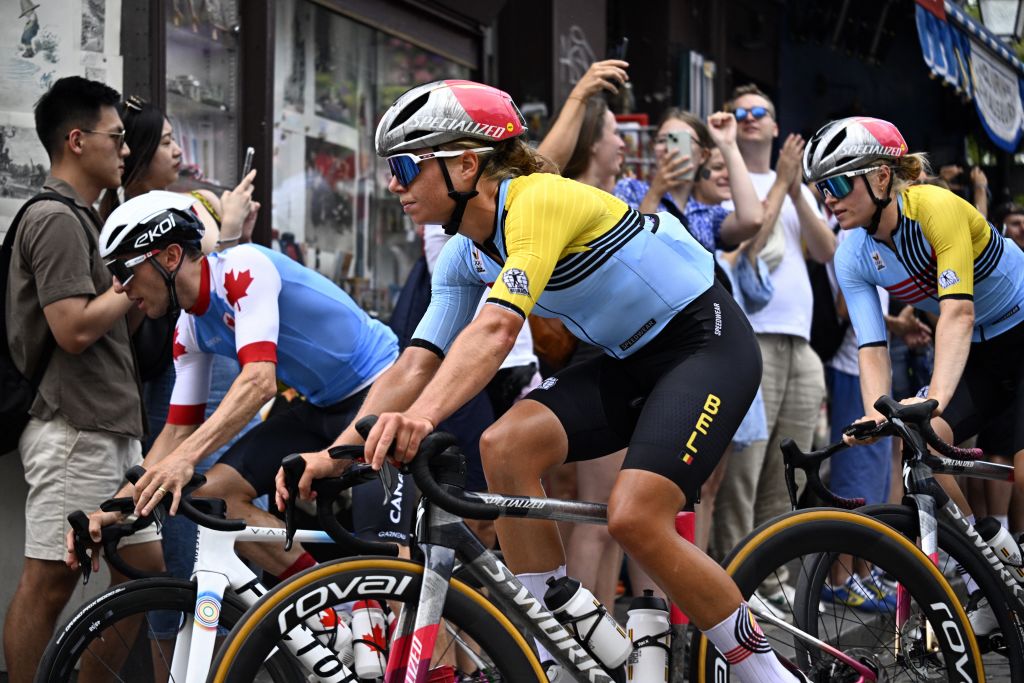The men and women due to compete in the Paris Olympic Games road races at the weekend got a chance to see the 18.4km finishing circuit, which passes the Moulin Rouge, Montmartre, and the Sacré Coeur church. They also got a taste of the city centre Parisian cobbles, which could play a factor in deciding the medal winners in the men’s road race on August 3 and the women’s road race on August 4.
The cobbled climb from the Moulin Rouge to Montmartre and then the fast descent below Sacré Coeur are considered to be the decisive points in the race, where attacks could be launched, and groups get away before a fight for the medal at the finish line a few kilometres away, across the Pont d’Iéna bridge between the Eiffel Tower and the Trocadéro.
The circuit was closed for two hours between 4:00 pm and 6:00 pm local time on Thursday, but traffic control was impossible to enforce, so the riders agreed to ride around the circuit together at an average speed of 30km/h. They were able to test their legs at race speed on the climb on subsequent laps.
Mathieu van der Poel opted against the controlled recon ride and trained with his Netherlands teammates in the quieter country roads to the west of Paris. Most other riders completed several laps, including time trial gold medalist Remco Evenepoel, his Belgian teammates, Poland’s Kasia Niewiadoma, and the USA’s Matteo Jorgenson and Chloé Dygert.
“It looks the route of a Flemish classic,” Belgian Sven Vanthourenhout recently told French-speaking Belgian newspaper La Derniere Heure.
“There’s no need to tell you that our Belgian riders will like it, but not just them.”
Athletes preview Montmartre

The men’s 90-rider entry list includes Evenepoel, Wout van Aert, van der Poel and Jorgenson but also France’s Julian Alaphilippe, mountain bike gold medalist Tom Pidcock (Great Britain), Mads Pedersen (Denmark), Biniam Girmay (Eritrea) and Michael Matthews (Australia). All are potential medal winners.
The latest race content, interviews, features, reviews and expert buying guides, direct to your inbox!
Lotte Kopecky (Belgium), Elisa Longo Borghini (Italy), Kasia Niewiadoma (Poland) stand out on the women’s start list, while Lorena Wiebes, Demi Vollering and Marianne Vos will share leadership in the Netherlands teams. Chloé Dygert is part of the USA, but it is unclear if she has recovered from her time trial crash.
The men race for a total of 273km, while the women face 158km, both with a long loop into the rolling French countryside to the southwest of Paris. The men and women return to the city with 60 km to race, passing by the Louvre on the way to the finishing circuit. It will mark the start of the ‘final’ of both races, the speed will rise.
When they see the Moulin Rouge, the riders turn right into Rue Lepic to begin the key climb. The narrow road will create a bottleneck, and positioning will be important. Montmartre is climbed with 46km, then 28km, and finally 9.5km to go.
The road climbs up for a kilometre on urban French cobbles. They are smoother than the cobbles of Paris-Roubaix but are still cobbles, and so impact the ability to put down power.
The first section of the climb passes the Café des Deux Moulins, where the movie Amélie was filmed, the road then curves around the side of the hill, reaching the peak at Butte Montmartre, close to the Place du Tertre, famous for the Montmartre painters. The roads are narrow and will be packed with spectators in the many bars and restaurants.
The route descends in front of the step of the Sacré Coeur church for the rest of the 18.4km circuit, which is covered twice. After the third climb of Montmartre the route returns to the Louvre and then follows the south bank of the Seine to the finish.
“It will be important to start the climb in a good position because it’s difficult to move back up. There is room for three riders at the most across the road,” Vanthourenhout warned.
“The Classics riders are used to this kind of terrain, but it will be a key point of the race. The cobbles are not as rough as, say, the Koppenberg climb, but they are not smooth either.”
Preview Paris Olympic Games men’s and women’s road race maps and profiles.
Other key points

The Montmartre climb is decisive but Vanthourenhout and others warned of other key points on the circuit that could be perfect to launch a decisive attack.
Italian journalist Michele Pelacci rode the whole circuit in the early summer for the al Vento magazine and identified a two-kilometre climb at 4% near the Chapeau Rouge park.
There are more cobbles along Rue du Faubourg du Temple and several sharp corners, while there is a short but steep section near the metro station. He suggested the circuit was harder than the circuit used for the World Championships in Wollongong, Australia, where Evenepoel and Annemiek van Vleuten won, but easier than the 2023 Glasgow city centre circuit, where van der Poel and Lotte Kopecky won the rainbow jersey.
The Belleville climb is about five kilometres before Montmartre and is climbed at 5% for a kilometre. It could be a good place to make an attack,” Vanthourenhout said.
“It’s followed by a flat section rather than a descent, so riders can push on there. It reminds me of the climb where Julian Alaphilippe attacked during the 2021 World Championships in Leuven. Perhaps it is where the medals will be decided.”
Get unlimited access to all of our coverage of the 2024 Olympic Games – including breaking news and analysis reported by our journalists on the ground from every event across road, mountain bike, track and BMX racing as it happens and more. Find out more.

